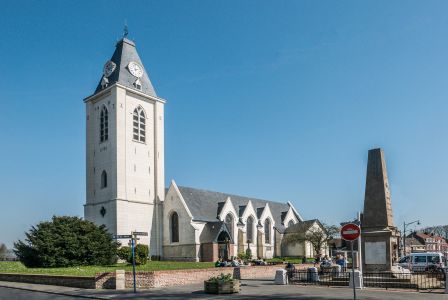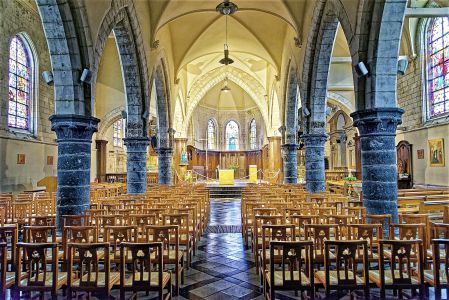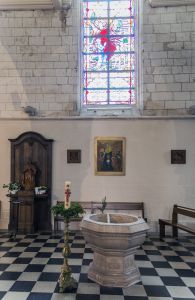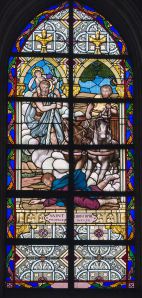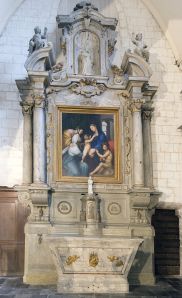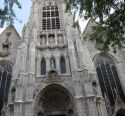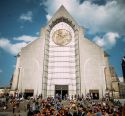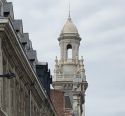Church | XIII-XIX | Gothic | Catholic Church




Map
Opening hours
01 January - 31 December
Mon 8.00 - 19.30
Tue 8.00 - 19.30
Wed 8.00 - 19.30
Thu 8.00 - 19.30
Fri 8.00 - 19.30
Sat 8.00 - 19.30
Sun 8.00 - 19.30
Religious offices
Monday to Friday : 19.00
Description
The church of Saint-Sébastien bears witness to this history since the 13th century, although texts mention the church of Annappes as far back as the 11th century. Students at Besançon University have carried out a dendrochronological analysis of the church's roof structure, dating it to 1291. The original ceiling is now obscured by a vault installed in 1929.
The church was originally built without a bell tower, in white limestone with a sandstone base. The church was enlarged in the 18th century to take on its current appearance in Lezennes stone, based on a hall-church plan with three naves of equal size.
The church is dedicated to Saint Sebastian, the Roman martyr and patron saint of archers, in homage to the relic of Saint Sebastian entrusted to the archers' brotherhood founded in 1517.
Photos
Remarkable elements
Stained-glass windows
In 1927, eleven Art Deco stained-glass windows were created by the Lille workshop David et Plateaux. Each window was financed by an Annappes family or association. They are figurative and deal with different themes: the figure of Saint Sebastian, Saint Christopher, a scene from the Holy Family in Joseph's carpenter's workshop, Saint Theresa at the bedside of a wounded soldier, etc.
The three stained glass windows in the choir were replaced in 2000 by works by master glass artist Étienne Tribolet, offering an explosion of colour.
Funerary chapel of the Brigode and Montalembert families
This monumental chapel is actually a trompe-l'œil. Built in 1816 in painted wood imitating marble, it was designed for a large family of landowners. These two families from the French nobility left their mark on local life by becoming the town's first mayors. Under the Empire, the Brigodes were awarded the title of baron.
Organ
This organ was built by the organ builder Victor Gonzalez in 1949 for the Paris music salon of the famous organist Gaston Litaize (1909-1991). Blind from birth, Litaize entered the Institution des Jeunes Aveugles in Nancy at the age of 12, where he took organ lessons with Charles Mangin. He went on to perfect his art with such great names as Adolphe Marty and Marcel Dupré.
He was titular organist at Notre-Dame de la Croix de Ménilmontant in Paris, then at Saint-Cloud, before ending his career at Saint-François-Xavier in Paris. He remains one of the great organists and composers of his time.
In 1960, the organ was transferred to the chapel of the Pères Lazaristes de Bondues, before being installed in this church in 2007.
Altarpieces
Two 18th-century altarpieces in painted wood imitating marble can be seen in the church.
- The altarpiece of Saint Sebastian: an 18th-century painting on canvas depicting the handing over of the keys to Saint Peter.
- The altarpiece of the Virgin Mary: a painting on canvas depicting the Holy Family: the Virgin Mary and the Child Jesus, accompanied by her cousin Saint John the Baptist and his mother, Saint Elizabeth. A young saint also appears in the scene. This 19th-century painting is a copy after Raphael.
Notre-Dame de la Treille
Representation of the Virgin and Child behind a trellis. Both are crowned: the Virgin holds a sceptre surmounted by a lily, and the Child Jesus carries the crucifixion orb. This image is reminiscent of Notre-Dame de la Treille in Lille.
As early as the 11th century, a 12th-century Virgin and Child, carved in stone, crowned and seated on a throne, was venerated in the collegiate church of Saint-Pierre in Lille. Her left hand held the Child on her knee, and her right hand a sceptre. This representation, known as Notre-Dame de la Sagesse (Our Lady of Wisdom), is a Sedes Sapientiae mosane, typical of the Romanesque schools of art in the Liège region.
One hypothesis concerning the name Treille traces its origins back to the Carolingian estate of Asnapio. This land, surrounded by a stone wall, included an imperial house, vineyards and a port of embarkation. It bore the name Treola, which is thought to have been deformed into Treille.


